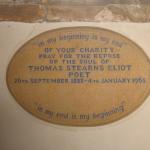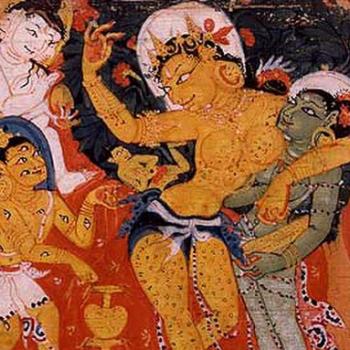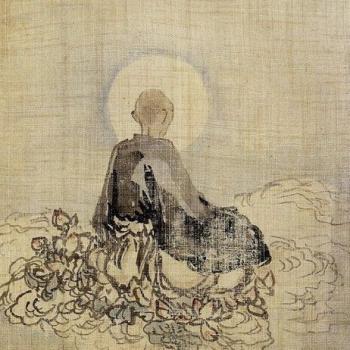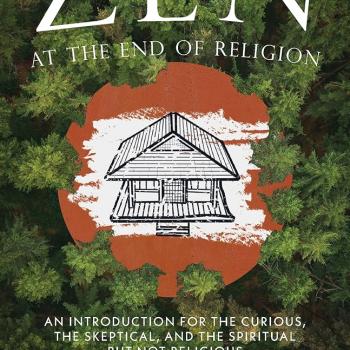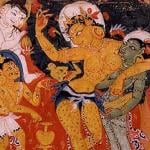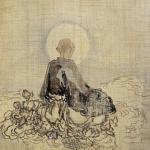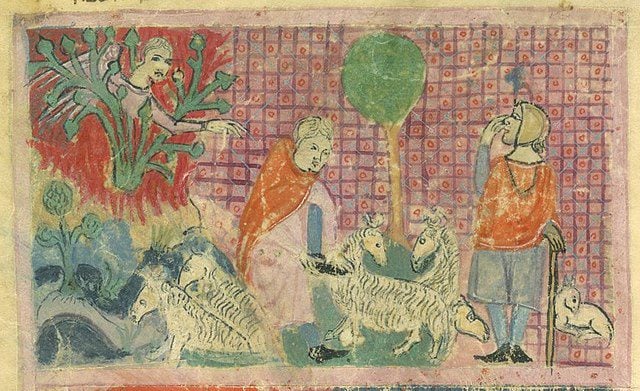
Sister Haggadah
14th century
(At the close of the year our Zen sangha held a Rohatsu retreat. There were several talks I thought should be shared a bit more widely. I’ve gathered permission and here is the first among them. It was given by the Reverend Tetsugen Tom Baker. Tom is a Zen priest in the lineage of Shunryu Suzuki. He is a long time teacher at the juncture of recovery and Buddhist meditation.)
“Be still and know that I am God.” This invitation from Psalms points to the importance of stillness in spiritual work. It is the ground for exploring the topic of this retreat, “Awakening to the World.” Our time together this weekend is spent in stillness and silence. Awakening, though born of stillness, is a dynamic process. Awakening is a spiritual journey, not a destination. It leads to nothing less than a profound shift in consciousness, and often a reevaluation of beliefs, values, or priorities. Most importantly for this talk, it can lead to healing.
I will be talking about “awakening” from both Buddhism and Christianity perspectives. I find these approaches to be complementary. Both traditions pointing toward mindful living and compassionate action. I will also propose a universal need for awakening and walk you through a practical example of a path to awakening.
I have been a student of Zen for close to 20 years, and recently began to explore the Christianity of my youth through the lens of my Zen practice. I am struck by St. Luke’s declaration, “The Kingdom of God is within you.” This resonates deeply with me. I have spent time in the Hell realms. I have lived in the realm of the Hungry Ghosts. I have inhabited the animal world, the human world, and the world of the devas. I have experienced the Divine. This is the whole Circle of Life, and it exists inside of me, and inside all of you. Every one of you is perfect. You have everything you need. And, as Suzuki-Roshi famously added, “You could use a little work.” Awakening is that work.
In the Christian tradition awakening involves attuning to a Divine presence and living in that divine love. Christ is offered as the expression of that love. More than the dogma, like Thich Nhat Hanh I am moved by the Christ story. His ministry is an example of compassion which is empathy leading to action. He ministered to those who suffered. This came from seeing their suffering, and being moved by compassion to acts of kindness and healing, much like the Boddhisatva Avalokiteshvara who is portrayed with 1000 eyes to see the suffering in the world, and 1000 arms to help all beings. Prayer helps to lead us into that Divine compassion. I’ll talk more about prayer in a moment.
In Buddhism, awakening refers to enlightenment, an insight into the nature of reality- things as they are. Dogen Zenji wrote, “Practice is enlightenment”. You could also say, “Enlightenment is practice.” Awakening is enlightenment is Practice is awareness. And enlightenment is nothing special. It is simply living with our eyes open. Easier said than done.
Like Christianity, this enlightenment/awakening is expressed in compassionate action. This is the Boddhisatva Vow: to live for the benefit of all beings. My friend Jeffrey Schneider explained living by the Boddhisatva Vow with this story. “You are on a long trek through the wilderness. You have walked for several days without seeing any signs of another human being. You come to a clearing and see a barn. This barn is incredibly long, so long that the end recedes into the forest. You cannot see the end of the barn it is so long. As you near the barn, you start to hear crying. You open the door and see cribs lining both sides extending beyond your vision. Each crib contains a crying infant. They all need to be fed, their diapers need to be changed, and they need to be held and soothed.
What do you do?
What do you do?
I suggest you pick up the first baby and start taking care of it. Then the next, and the next, and so on and so on and so on….”
Both traditions, Christian and Buddhist, answer a fundamental need to awaken to our lives. In “The Teachings of the Buddha “, it is recorded that Buddha said, “Just as a candle cannot burn without fire, men cannot live without a spiritual life.” This need appears across all cultures and time. From what I can tell, it appears in all religions, faith traditions, and indigenous practices. This is fundamentally the need for a transcendent experience. This transcendence is a state of being where one goes beyond ordinary perceptions and limitations. Often a spiritual or religious state, it is also seen in rave music culture and psychedelic drug use. It broadens and intensifies our outlook and provides a greater sense of connection. A greater sense of community.
Religious rituals often evolve as attempts to recreate the founder’s original transcendent experience. I had a professor who described this experience as “Something Happened.” Our sitting practice grew out of the Buddha’s transcendent experience sitting under the Bodhi tree and awakening. Similar transcendent experiences include Christ’s resurrection, and Moses at the Burning Bush. “Something Happened.” In each case, the experience was an awakening, and the result of a spiritual journey.
Tonight, I want to offer the 12 Steps of recovery as a roadmap of one type of spiritual journey. This is a path of personal and spiritual growth, and it leads to waking up. I have experienced this waking up. My experience in addiction was like a dream. I was basically sleep-walking for many years, barely aware at times what was going on. I had little control over what substances I was putting into my body. It was a fugue state, and I look back on it like a nightmare at times. My drug of choice was alcohol, followed by whatever I could get.
It is interesting that alcohol is often called “spirits”. The origin of the word “spirit” is the Latin “spiritus” meaning “breath”. It was associated with the supernatural (and the divine). This dates to 14-century alchemists. They noticed that the transformation in consciousness that occurred when someone drank alcohol was like an alchemical process. They thought this supernatural, hence the name.
At an early age I learned that I could change my consciousness with chemicals. It was transcendent in many ways. When using substances, I felt connected to people, and my reality was changed. For example, psychedelics showed me the intractable nature of my home situation and suggested a way out. I think that chemical abuse can be the near enemy of the desire for transcendence, an escape from difficult places. This could be partly why there is such a strong correlation between childhood trauma and addiction. We learned at an early age to change that which we could not tolerate.
Recently I read “The Intimate Way of Zen” by James Ishmael Ford. In it he describes three fundamental motivations for a spiritual quest. First, noticing something is wrong. Second, discovering a hope that things can be better. Third, setting an intention to strive to make things better. I was struck by how closely these mirrored the first 3 steps in the 12 Step program. These first 3 steps are all that is needed to start this spiritual journey. In the first step, we admit we can’t control the substance, or the behavior (something is wrong). In the second step we came to believe recovery is possible (discovering hope). Third, we turn our will over and start working the rest of the steps (making an intention.)
The remainder of the Steps are movement along this path and are based on spiritual principles. In Steps 4 and 5 we engage in deep self-examination. We look at our fears, resentments and harms done. We put this to paper and share this with a trusted spiritual friend and whatever Higher Power you want. It is important that we take refuge in the Sangha in this and not go it alone. I did this for the first time with a dear woman who was helping me. As I was reading it, I suddenly felt a presence in the room, a warm, healing, beneficent presence. We were alone. She then asked, “Do you feel that?” We both did. Was this the Holy Spirit? The ghosts of my ancestors? A psychological trick? Mass delusion? I don’t know. I just know that “Something Happened” and it changed my life.
In Steps 6 and 7 we look at the habit energy behind our actions, actions that caused suffering in ourselves and others. Very often these tendencies are the remains of defense mechanisms that no longer work. We then develop more skillful ways of moving through life.
Steps 8 and 9 give us the chance to change our karma by making amends to those we have harmed. They may or may not accept the amends, but the karmic repair has begun.
We use Steps 10 and 11 to develop a prayer practice and a meditation practice. We continue self-reflection. When I was first starting to pray in this context, I felt like a phony praying to a God in whom I didn’t believe. I told this to my Zen teacher who replied, “Which is more important: the reality of who you are praying to, or the sincerity of the intention in your heart?” This was the turning word I needed to start to develop an intention-based prayer practice.
Finally, the 12th Step states, “Having had a spiritual awakening as the result of these steps, we tried to carry this message to other addicts, and to practice these principles in all our affairs.” This is the main promise of the 12 Steps: that you will have a spiritual awakening after working the Steps. And the charge is then to be of service to others.
As a result of this awakening, I found healing. I found a way out of addiction.
This promise of a spiritual awakening is why I offered this model today. This model uses mindfulness and skillful action as tools on the Spiritual Path. These principles can be adopted by anyone. Deep self-reflection. Developing a trusted spiritual friend. Look at problematic behavioral tendencies, and work to balance our karmic effects on others. Pray. Meditate. Be of service.
The last thing I want to touch on was mentioned by the other Tom this morning. When we awaken, we awaken to everything, including all the negativity in the world. In the immediate wake of the recent election, my first reaction was to turn my back on it. I limited social media and stopped obsessively following the latest news bulletins. But the Boddhisatva does not to turn away from suffering. Ignoring suffering is not the Vow I took. I can protect my sanity by taking my news a little stale, as I have heard it described. I read analysis rather indulge in the never-ending flood of outrage.
We are in a bardo period right now between the election and the end of January. In the bardo you prepare for the next life. I am still exploring what that preparation is for this next phase. Our trans brothers and sisters will need us. Our immigrant neighbors will need us. Our planet needs us. Our democracy needs us. So, my determination is to be ready. We will know when the time for action is here. I pray for courage to act.
In conclusion, awareness is transformative process whether Christian, Buddhist, or other traditions. As The Thich Nhat Hahn pointed out, there is healing power in this work which is rooted in love and understanding.
“Enlightenment, for a wave in the ocean, is the moment the wave realizes it is water”


